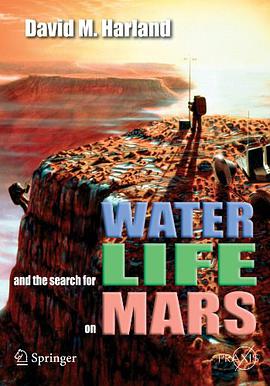

具體描述
Mars has long been believed to have been cold, dead and dry for aeons, but there is now striking new proof that not only was Mars a relatively warm and wet place in geologically recent times, but that even today there are vast reserves of water frozen beneath the planet's surface. As well as casting fascinating new insights into Mars' past, this discovery is also forcing a complete rethink about the mechanisms of global planetary change and the possibility that there is microbial life on Mars. David Harland considers the issue of life on Mars in parallel with the origin of life on Earth. At the time the Viking instruments were designed, it was thought that all terrestrial life ultimately derived its energy from sunlight, and that the earliest form of life was the cyanobacteria with chlorophyll for photosynthesis. It was assumed the same would be the case on Mars and that microbial life would be on or near the surface that the Vikings had sampled. No sooner were the results from the Viking instruments in, than it was discovered that there was an even older type of microbial life on Earth when, in 1977 'black smokers' were found in volcanically active parts of the ocean floor, at depths of several kilometres. Removed from sunlight, these archaea (literally, 'the old ones') live off the minerals released by the hydrothermal activity. Subsequently our view of life was further revised when 'extremophiles' were discovered thriving in acidic, salty, alkaline, very hot, very cold and radiation soaked environments previously considered lethal. Although the Vikings had found no sign of organics, and the surface was extremely hostile, suggesting that life had never gained a foothold, the discovery of microbes living far beneath the surface of the Earth raised the possibility of life below the surface of Mars, where there may be water-ice and/or hydrothermal activity. Perhaps, because the microbes were beyond the reach of the Vikings' instruments, the negative result was premature. Following the negative tests for biological activity by the Vikings, NASA -- in the belief that Mars was once warm and wet, as the erosional features on the surface suggest -- decided to 'chase the water' in the hope of establishing that conditions on Mars were once suitable for life, although this would not prove that life had developed. The targets selected (from many) were what seemed to be an outflow channel, a dry lake and a patch of minerals emplaced by hydrothermal activity. In 1997 Mars Pathfinder landed in an outflow channel where it released the small Sojourner rover to perform chemical analyses of nearby rocks. NASA followed up in 2004 with the much larger Mars Exploration Rovers, which were equipped to act as mobile field geologists. One was landed in what seemed to be a dried up lake bed inside a crater, and the other set down in an area that a remote-sensing orbital survey had identified as haematite, a likely indicator of hydrothermal activity. Both of these missions have yielded evidence that conditions were once conducive to the development of life. In parallel with these NASA projects, the European Space Agency developed the Mars Express remote-sensing orbiter, which has detected traces of methane that may have been released by microbes. If microbial life is found on Mars, will it be based on DNA? Will this indicate that life developed independently? Or that it has characteristics in common with the most ancient forms of terrestrial life? If life is found on two planets in the same planetary system, this would favour the panspermia hypothesis. And if martian life is radically different, then in light of the discovery of planetary systems around other stars, this would, as remarked by Philip Morrison of MIT, "transform life from the status of a miracle to that of a statistic". These are all questions that the exploration of Mars for life are aimed to answer.
著者簡介
圖書目錄
讀後感
評分
評分
評分
評分
用戶評價
相關圖書
本站所有內容均為互聯網搜索引擎提供的公開搜索信息,本站不存儲任何數據與內容,任何內容與數據均與本站無關,如有需要請聯繫相關搜索引擎包括但不限於百度,google,bing,sogou 等
© 2025 book.quotespace.org All Rights Reserved. 小美書屋 版权所有




















